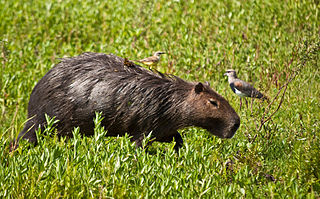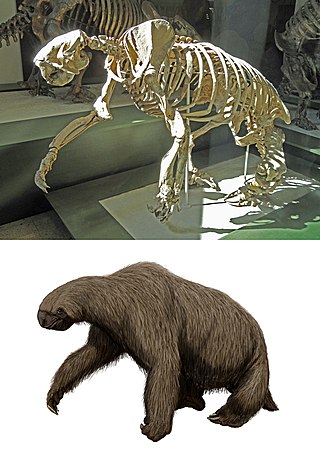
The capybara or greater capybara is a giant cavy rodent native to South America. It is the largest living rodent and a member of the genus Hydrochoerus. The only other extant member is the lesser capybara. Its close relatives include guinea pigs and rock cavies, and it is more distantly related to the agouti, the chinchilla, and the nutria. The capybara inhabits savannas and dense forests, and lives near bodies of water. It is a highly social species and can be found in groups as large as 100 individuals, but usually live in groups of 10–20 individuals. The capybara is hunted for its meat and hide and also for grease from its thick fatty skin. It is not considered a threatened species.

Ground sloths are a diverse group of extinct sloths in the mammalian superorder Xenarthra. Ground sloths varied widely in size, with the largest genera Megatherium and Eremotherium being around the size of elephants. Ground sloths are a paraphyletic group, as living tree sloths are thought to have evolved from ground sloth ancestors.

Caviidae, the cavy family, is composed of rodents native to South America and includes the domestic guinea pig, wild cavies, and the largest living rodent, the capybara. They are found across South America in open areas from moist savanna to thorn forests or scrub desert. This family of rodents has fewer members than most other rodent families, with 19 species in 6 genera in 3 subfamilies.

The genus Hydrochoerus contains two living and three extinct species of rodents from South America, the Caribbean island of Grenada, California and Panama. Capybaras are the largest living rodents in the world. The genus name is derived from the Greek ὕδωρ 'water' plus χοίρος 'pig'.
Heptaxodontidae, rarely called giant hutia, is an extinct family of large rodents known from fossil and subfossil material found in the West Indies. One species, Amblyrhiza inundata, is estimated to have weighed between 50 and 200 kg, reaching the weight of an eastern gorilla. This is twice as large as the capybara, the largest rodent living today, but still much smaller than Josephoartigasia monesi, the largest rodent known. These animals were probably used as a food source by the pre-Columbian peoples of the Caribbean.

The Great American Biotic Interchange, also known as the Great American Interchange and the Great American Faunal Interchange, was an important late Cenozoic paleozoogeographic biotic interchange event in which land and freshwater fauna migrated from North America via Central America to South America and vice versa, as the volcanic Isthmus of Panama rose up from the sea floor and bridged the formerly separated continents. Although earlier dispersals had occurred, probably over water, the migration accelerated dramatically about 2.7 million years (Ma) ago during the Piacenzian age. It resulted in the joining of the Neotropic and Nearctic biogeographic realms definitively to form the Americas. The interchange is visible from observation of both biostratigraphy and nature (neontology). Its most dramatic effect is on the zoogeography of mammals, but it also gave an opportunity for reptiles, amphibians, arthropods, weak-flying or flightless birds, and even freshwater fish to migrate. Coastal and marine biota, however, were affected in the opposite manner; the formation of the Central American Isthmus caused what has been termed the Great American Schism, with significant diversification and extinction occurring as a result of the isolation of the Caribbean from the Pacific.

Caviomorpha is the rodent infraorder or parvorder that unites all New World hystricognaths. It is supported by both fossil and molecular evidence. The Caviomorpha was for a time considered to be a separate order outside the Rodentia, but is now accepted as a genuine part of the rodents. Caviomorphs include the extinct Heptaxodontidae, the extinct Josephoartigasia monesi and extant families of chinchilla rats, hutias, guinea pigs and the capybara, chinchillas and viscachas, tuco-tucos, agoutis, pacas, pacaranas, spiny rats, New World porcupines, coypu and octodonts.

Megalonychidae is an extinct family of sloths including the extinct Megalonyx. Megalonychids first appeared in the early Oligocene, about 35 million years (Ma) ago, in southern Argentina (Patagonia). There is, however, one possible find dating to the Eocene, about 40 Ma ago, on Seymour Island in Antarctica. They first reached North America by island-hopping across the Central American Seaway, about 9 million years ago, prior to formation of the Isthmus of Panama about 2.7 million years ago. Some megalonychid lineages increased in size as time passed. The first species of these were small and may have been partly tree-dwelling, whereas the Pliocene species were already approximately half the size of the huge Late Pleistocene Megalonyx jeffersonii from the last ice age.

Hydrochoerinae is a subfamily of Caviidae, consisting of two living genera, Hydrochoerus, the capybaras, and Kerodon, the rock cavies. In addition, a number of extinct genera related to capybaras should also be placed in this subfamily. The taxonomy of Hydrochoerinae is confused because, until 2005, living capybaras and their extinct relatives were placed in their own family, Hydrochoeridae. Recent molecular phylogenetic studies recognize a close relationship between Hydrochoerus and Kerodon, supporting placement of both genera in a subfamily of Caviidae. Paleontological classifications have yet to incorporate this new taxonomy, and continue to use Hydrochoeridae for all capybaras, while using Hydrochoerinae for the living genus and its closest fossil relatives such as Neochoerus. The taxonomy of fossil hydrochoerines is also in a state of flux. In recent years, the diversity of fossil hydrochoerines has been substantially reduced. This is largely due to the recognition that capybara molar teeth show strong variation in shape over the life of an individual. In one instance, material once referred to four genera and seven species on the basis of differences in molar shape is now thought to represent differently aged individuals of a single species, Cardiatherium paranense.
The Caribbean bioregion is a biogeographic region that includes the islands of the Caribbean Sea and nearby Atlantic islands, which share a fauna, flora and mycobiota distinct from surrounding bioregions.
The blunt-toothed giant hutia is an extinct species of giant hutia from Anguilla and Saint Martin that is estimated to have weighed between 50 and 200 kg. It was discovered by Edward Drinker Cope in 1868 in a sample of phosphate sediments mined in an unknown cave in Anguilla and sent to Philadelphia to estimate the value of the sediments. It is the sole species of the genus Amblyrhiza in the fossil family Heptaxodontidae.

The lesser capybara is a large semiaquatic rodent of the family Caviidae found in eastern Panama, northwestern Colombia, and western Venezuela. The lesser capybara was described as a species in 1912, but was later re-categorized as a subspecies of the capybara. Following studies of anatomy and genetics in the mid-1980s, it was recommended that it again should be recognized as a separate species, and this gained more widespread recognition in 1991, although some continue to consider it a subspecies.
The mammalian order Pilosa, which includes the sloths and anteaters, includes various species from the Caribbean region. Many species of sloths are known from the Greater Antilles, all of which became extinct over the last millennia, but some sloths and anteaters survive on islands closer to the mainland.
A unique and diverse albeit phylogenetically restricted mammal fauna is known from the Caribbean region. The region—specifically, all islands in the Caribbean Sea and the Bahamas, Turks and Caicos Islands, and Barbados, which are not in the Caribbean Sea but biogeographically belong to the same Caribbean bioregion—has been home to several families found nowhere else, but much of this diversity is now extinct.
Neochoerus aesopi was a relatively large rodent species native to North America until their extinction about 12,000 years ago, being closely related to modern capybaras. It was part of the subfamily Hydrochoerinae. Fossils of it have been found in U.S. states such as Florida and South Carolina. The species was originally outlined in 1853, it weighed about 80 kg similar in size to the modern day capybara.

Megalocnidae is an extinct family of sloths, native to the islands of the Greater Antilles from the Early Oligocene to the Mid-Holocene. They are known from Cuba, Hispaniola and Puerto Rico, but are absent from Jamaica. While they were formerly placed in the Megalonychidae alongside two-toed sloths and ground sloths like Megalonyx, recent mitochondrial DNA and collagen sequencing studies place them as the earliest diverging group basal to all other sloths. They displayed significant diversity in body size and lifestyle, with Megalocnus being terrestrial and probably weighing several hundred kilograms, while Neocnus was likely arboreal and similar in weight to extant tree sloths, at less than 10 kilograms.

Hydrochoerus hesperotiganites is an extinct species of capybara that lived in San Diego County, California, during the Rancholabrean stage of the Pleistocene. It is currently the only known capybara of the genus Hydrochoerus found in North America. It was closely related to the modern Greater and Lesser Capybara.

Ortotherium is a genus of megalonychid ground sloth from the Late Miocene Ituzaingó Formation of Entre Rios Province, Argentina. Although many species were described, the only valid species of the genus is Ortotherium laticurvatum, with many species being junior synonyms. Ortotherium is known from very fragmentary material, all of which is material from the mandible and teeth. The holotype of O. laticurvatum consists of an incomplete left dentary that had been unearthed from a series of sediments known as ‘Conglomerado osifero’ in Paraná, Argentina. Argentina paleontologist Florentino Ameghino named the species in 1885, though he would go on to name four more, invalid, species of the genus. One species however, O. brevirostrum, has been reclassified as Mesopotamocnus.










